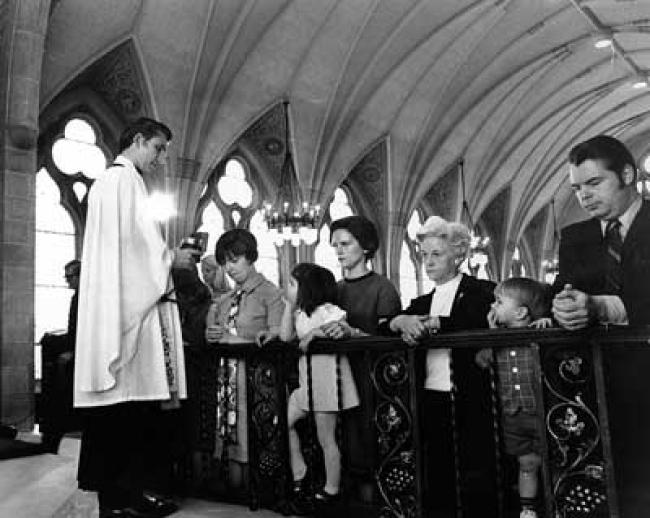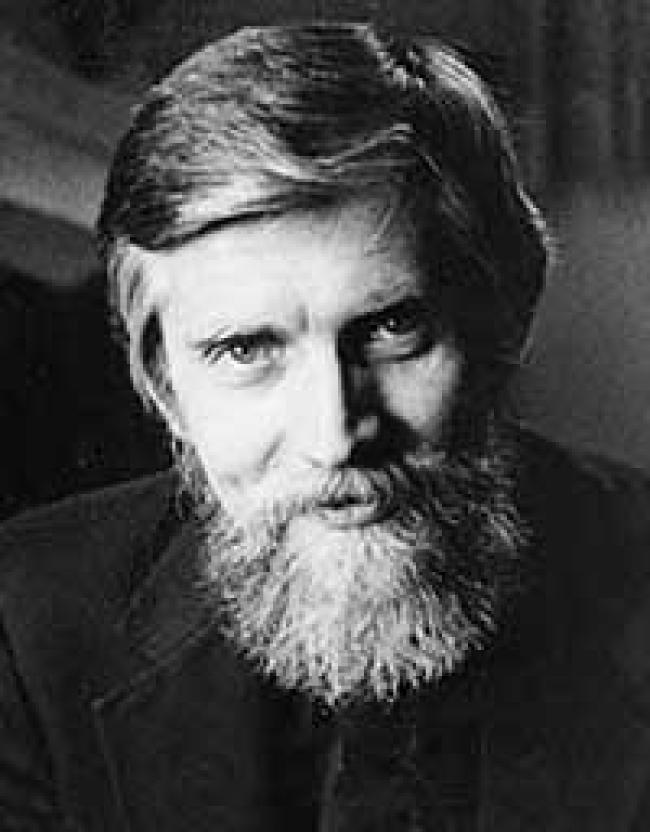Altar rail revolution: Campus Church, 1966-83
(This story was written in celebration of Augustana's sesquicentennial in 2010.)
What began as an experiment in alternative forms of campus ministry wound up having some lasting impacts at Augustana College. But considering the many ways in which the Augustana Campus Church rewrote the rulebook on how to do ministry on a college campus, it might be surprising to learn that it all started with a meeting of nine middle-aged white men.

The idea of forming a campus congregation with its own pastor had been raised at least twice before at Augustana; the Observer reported such initiatives in 1906 and 1926. But not until the 1960s would the idea take root.
It wasn't just the nascent movement toward student independence that prompted President C.W. Sorensen to call a meeting at his home on Feb. 24, 1964. By this time, the recent merger creating the Lutheran Church in America precipitated the Augustana Seminary's move to Chicago, and Sorensen certainly must have understood the implications this would have for the college's identification with the new denomination.
And so the time was ripe for change when Sorensen invited the Rev. Dr. Robert Marshall, president of the LCA's Illinois Synod, to his home for a meeting which included Dr. George Arbaugh, Dr. G. Kenneth Andeen, the Rev. Earl Lusk, Dr. Ralph W. Hansen, the Rev. Emerson Miller, the Rev. John Kindschuh, and Dr. Louis Almen. Together, they drew up plans for a congregation that would be jointly funded by the college, the synod, and its student members.
The birth of student leadership
After gaining initial approval from the board, Sorensen convened a planning committee made up entirely of students. A freshman member of the committee, Peter Benson '68, would be around to see the idea unfold. "'I think the spring of 1965 saw the birthing at Augustana of the national movement toward student engagement in leadership,' he says. 'We thought, ‘We can make something happen. We can create change, we can do this.''"
Benson, who was president of the Representative Assembly in 1967-68, carried that spirit throughout his years at Augustana, launching the Free University with classes at the end of the day and on weekends dealing with subjects that mattered to students, including one on the morality of war.
"It was certainly a student awakening, with students wanting in on governance. We were trying to bring our ‘Big Questions' about the world into the curriculum," Benson says. What was needed in order for the Campus Church to thrive in this milieu was a pastor open to letting students take the lead.
'Swanie' had to be the guy
"I like to take credit for the idea that 'Swanie' had to be the guy," Benson says, referring to the students' decision to call the Rev. Richard Swanson '54, then pastor of St. Matthew Lutheran Church in Itasca, Ill., to lead the Campus Church. "But the fact is, a lot of students knew him already because of the great things he'd been doing at Camp Augustana" (the Lake Geneva, Wis., summer camp of the former Augustana Synod).

Benson says students wanted an adult on campus who understood them and took seriously their ethical, moral, and political questions. "With Swanie you could be yourself, talk Big Ideas and open up new channels of connection."
Music provides one sign of Swanson's suitability for the pastorate: At his "high church" installation service on Jan 8, 1967, a work by George Friderick Handel was used as the processional and the postlude was a piece by Dietrich Buxtehude. Two years later, the March 5, 1969, Observer reported that Swanson had replaced the organ with a rock band. Music professor and Campus Church collaborator Tom Robin Harris tried to assuage the Observer's concerns by noting a distinct "baroque influence" in the music of Procol Harum.
The pace in those early years was dizzying. Swanson channeled students into their areas of interest, and soon Augustana Campus Church was helping sponsor Augustana's Black Power Symposium in 1969, when 2,000 people packed Centennial Hall to hear Dick Gregory, Roy Innis, Jesse Jackson and others (the number of black students at Augie more than trebled in the ensuing five years). From this grew Racial Reconciliation, a dialogue that brought people together on campus, and raised funds for two Augustana students — Giovanni Medlock and Randy Middleton — to study abroad at a university in Ghana.
Augustana Voluntary Action, another Campus Church ministry, sent students to juvenile detention centers, the East Moline State Hospital, and the Rock Island County TB Sanatorium. Through a roundabout set of circumstances, this initiative led Campus Church into uncharted ecumenical territory. Students crafted the Cornerstone Ministry to support child development in the neighborhoods to the east of campus, and wound up bringing together St. Mary's Catholic Church in Moline, St. John's Lutheran in Rock Island, and First Lutheran in Moline in one of the first Catholic-Lutheran partnerships in the region.
The communion controversy
But the change that caused the greatest stir, and one that would trouble waters across the national church, ironically had the least to do with students themselves. Swanson nonetheless found a way to rope them into a national controversy.

Since its beginnings, Campus Church had been open to faculty families, as well as some from the surrounding community. In 1970, the congregation decided it would offer Holy Communion to all baptized Christians, and children would be offered the sacrament at the discretion of their parents. In the Augustana Synod of Swanson's youth, communion came only after confirmation; now as a pastor himself, Swanson couldn't find a reason why any baptized person should be prevented from communing.
Speaking to an Illinois Synod Convention in 1971, Swanson presented his case in a paper called "Font to Altar: A Lutheran Progression." In laying out his case, he called the practice of withholding communion from children "objectionable":
It is as though an infant member were to be warmly welcomed at a family reunion, only to be denied participation in the reunion because he does not yet understand the meaning of family. Stated more extremely, it is as though a woman, having endured the great pain and sacrifice which bring a child into the world, would then deny the infant milk from her breast because he does not yet understand the full meaning of her love and suffering for him.
Swanson appointed a task force of students and faculty to study the issue, even though one of the task force members, current Augustana Chaplain Richard Priggie '74 says there wasn't much controversy on campus. "We were rather proud of the practice," Priggie says. Task force member Jack Hullett, then a young psych professor who would later serve as dean of admissions at Augustana, wrote a paper on the question from the perspective of child psychology, arguing that the inclusion of children benefited not just them but the entire community. But none of it changed the national church's stance.

Although officially proscribed by the church, Swanson continued communing kids. Dr. Marshall, who would go on to become the president of the LCA and remain a staunch supporter of Swanson's throughout the latter's ministry, apparently turned a blind eye. It wasn't until 1997 that the successor to the LCA, the Evangelical Lutheran Church in America, approved a statement called "The Use and the Means of Grace" that somewhat resignedly admits, "There is no command from our Lord regarding the age at which people should be first communed."
A legacy of openness
The Campus Church continued at Augustana until 1983, when it was replaced with a more contemporary campus ministry structure. But the spirit of openness to new thinking continues: In addition to Chaplain Priggie and Catholic Chaplain Marilyn Ring, O.S.B., Augustana has Jewish and Muslim student advisors, and dedicated prayer space in the Tredway Library for Muslim students.
Two of the students on the original 1965 planning committee — Diane Gustafson Hill and Peter Benson — today serve on the Augustana Board of Trustees, and a third, Barbara Lundblad, will present the sermon at the Sesquicentennial Baccalaureate worship in May. Today Lundblad, who would not have been eligible for the ministry in the 1960s because of her gender, holds the Joe R. Engle Professorship in Preaching at Union Theological Seminary in New York.
As for Swanson, he continued at Augustana until his retirement in 1999. He died in 2005, but is remembered on campus through the Richard Swanson Professorship in Social Thought, the Swanie Slough Path, an environmental advocacy fund started by faculty members, and a scholarship he and his wife, Lorian, established to assist minority students in attending Augustana College.
— Kai Swanson ‘86
Executive Assistant to the President
